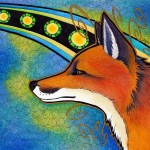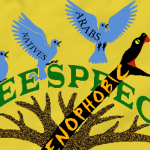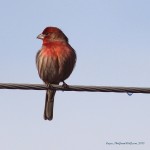Warning: This post contains graphic discussions of animal cruelty.
This past weekend I vended at the Shrewsbury Renaissance Faire in Kings Valley, OR. It’s one of the most established faires in the Portland area, having been started in 1995, and after I missed last year I was eager to make it back this year. The faire is currently held in a big grass field south of Dallas, OR; the field had been mowed so the grass could be sold as hay, and so all that was left was a bit of dry stubble in the dust. This made it easier for people to walk around–and it also made for excellent vole-watching. The entire field, in fact, is pockmarked by the burrows of voles (probably creeping voles, Microtus oregoni), and we spent the weekend watching on particularly bold little critter popping out of her burrow and wandering the field around our booth and others. She even burrowed around underneath our air mattress at night, as evidences by the trails in the grass and dust underneath–a very determined little vole indeed! (I took the opportunity to subject my partner to several truly terrible vole puns throughout the weekend. Vole-tron. Vole-demort.)
Shrewsbury is quite family-friendly, and there were plenty of kids running around throughout the weekend. Several of the surrounding booths had children who would pass by our booth with some frequency. At one point late in the day on Saturday, one boy near my booth happened to mention to me “I’m going to squash a vole”. I stopped, not sure if I’d heard correctly. “What did you say?” I asked. “I’m going to squash a vole,” he repeated. He couldn’t have been more than about eleven or so, and he pointed at the burrow near the front of our booth where we’d been watching our vole neighbor all day.
I gave him a stern look and said “Don’t you dare. There’s no reason to kill an animal just because it’s there, and this is from someone who’s selling art made from animal hides.” The boy looked chastised and retreated back over to his own booth. I retreated as well; it was a reminder that people, children included, too often see the killing of another life as something to be taken lightly.
I recently read and reviewed Hal Herzog’s Some We Love, Some We Hate, Some We Eat: Why It’s So Hard to Think Straight About Animals, a well-written text that raises many questions–and few simple answers–to the seeming contradictions in how we treat our fellow non-human animals. One of the most poignant parts of the book was when the author casually interviewed several people he knew, and found that childhood cruelty to animals is possibly more common than we think, not just in those who grow up to be murderers and abusers, but everyday people who as adults have pretty mainstream ethical boundaries. Herzog cites research done by sociologist Arnold Arluke that shows just how common childhood animal cruelty is. Arluke didn’t have to interview teen delinquents and adult prisoners; instead, he interviewed students in his own classes at Northeastern University:
The students he interviewed had poisoned fish with bleach, ripped the legs off flies, burned grasshoppers with lighter fluid, and played Frisbee with live frogs. This statement by a woman he interviewed is typical: “It was like was didn’t have anything to do and we were bored, so it’s like “OK, let’s go torture some cats!”
Arluke’s students were not an anomaly. In one recent study of college students, 66% of male students and 40% of female students admitted that they had abused animals. Arluke has come up with a radical suggestion. He believes that for many children, animal cruelty is a normal part of growing up. He calls it dirty play…The awkward fact is that the most wanton animal cruelty is not perpetrated by inherently bad kids but by normal children who will eventually grow up to be good citizens. (Herzog, 33-34.)
I have to admit that, even though I absolutely loved animals as a kid, I was also guilty of atrocities that today make me cringe–I used live grasshoppers as fish bait, I fried ants with a magnifying glass, and one of my earliest memories as a toddler is of drowning roly-polies in a puddle and then crying because they were dead. So I had to remember that this boy was probably the same way. Not a future serial killer, but some kid who maybe didn’t know better, or who had a disconnect between his natural empathy and his impulse to “squash” a vole that had been running around booths and startling people. After all, we get a lot of messages in American culture that mice, voles and other rodents are pests to be killed, not wildlife to be appreciated. Sure, I’d be freaked out if I found the vole in my home, and it was easier to appreciate her running about on her own territory.
But part of being an adult is being able to make abstract decisions and conscious ethical choices. After all, I mentioned to this child that I was someone who sold art made from hides and bones, and yet here I was telling him not to kill an animal just because it existed. This reflects the basic quandary brought up in Herzog’s work: why do I have pouches made from vintage mink fur, fox tails left over from garment manufacture, and leather goods produced from secondhand clothing (but originally made by cows and pigs), and yet I all but stand guard over the burrow of one little vole that likely won’t last another year?
A lot of it is due to purpose. Many of my art materials (both animal remains and otherwise) are secondhand or otherwise reclaimed, and I repurpose them into wearables and other art meant to honor the animals and their lives. I would never kill an animal just to incorporate it into art; I generally use things that are the byproducts of other industries. I’m also an omnivore who supports free range farms as much as I can afford, though I know the meat I eat still came from a dead animal. But these things have reasons behind them; it’s not just killing for the sake of killing. I don’t support the hunting of coyotes just because they’re coyotes, though there are ranchers and farmers who think there’s no such thing as a good, live coyote. I don’t like trophy hunting, and especially not by hunters who take the prized horns and leave the rest of the deer to rot. And I don’t think that boy should have killed a vole simply because she was in her home territory while we were the invaders for a few days.
I hope he remembers this incident. I didn’t have someone telling me to leave the poor ants alone as I watched them shrivel in the concentrated heat under the magnifying lens. I wish I’d had. Maybe I was projecting a little by telling him to leave the vole alone, trying to echo my voice back thirty years. Maybe I was trying to exorcise a bit of the guilt I still feel for my childhood errors, and the awareness I have of my hypocrisy as an adult–a hypocrisy that most Americans share to one degree or another.
Not that the vole cared. All that mattered to her was that she survived the onslaught of hundreds of humans and our noisy vehicles, just days after the cutting down of her grassy cover. On our last night, after the event ended and we packed out our booth, we left the headlights on over her domain so we wouldn’t step on her, and we carefully backed the car out when we were done. Perhaps she’d only have a few days or weeks left before a raptor or fox caught her out in the short grass, or maybe she’d live to have several litters (or father them, if our vole turned out to be male instead). But we wanted her to have that opportunity, at least, and we wished her well as we left her to her devices in the cool night.












